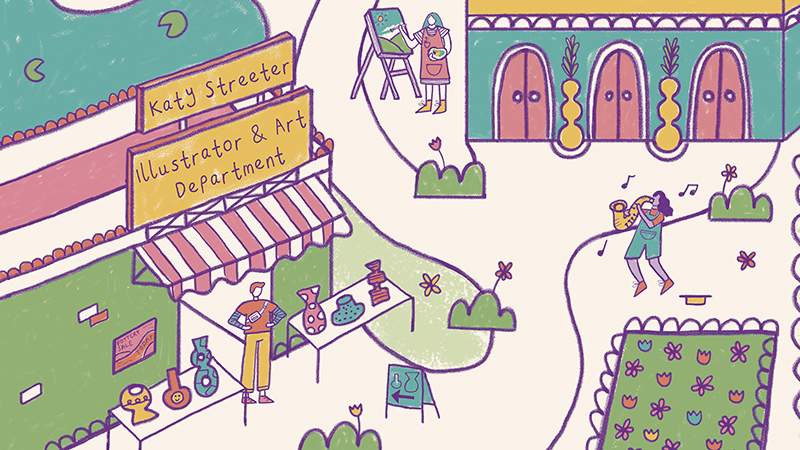I’m Katy Streeter, a freelance illustrator based in Kent.
It’s been eight long months since I graduated from University for the Creative Arts with a first in Illustration and Animation (woo!), and I feel like I’ve crammed a lot into that short space of time.
I’ve picked up some editorial illustration commissions but I’m still learning, figuring out where I want to be, and making plenty of mistakes.
Hopefully, some of the things I’ve learned since graduating might bring some clarity, especially if you’re looking to freelance after uni.
Co-workers not competition
Some of the most valuable things I’ve learned have come from other illustrators I admire. I’ve found the illustration community to be a lovely bunch who are more than happy to chat, give advice or offer some direction.
Even those seemingly untouchable with masses of followers. Sending an encouraging direct message or writing a kind comment will make you both feel good. If you see a job opportunity that doesn’t fit you, send it to someone who it would suit. And sharing things with others may mean they will return the favour too.
The people you study with are the first people in your professional network. Lean on each other, support each other and collaborate.
I’m still navigating the illustration world with the help of my uni pals, we’re all in a similar boat and there’s some comfort in that.

Finding clients is a numbers game
I’ve been working largely in editorial and have found most of my freelance opportunities through sending cold emails.
It sounds intrusive, but it’s a very common practice and a great way to find new clients and establish connections. Here’s one way to reach out: – Research companies you love and think your work would suit. – Always try to find the name and email address of the art director of the company.
The best place to find them is from the companies website or by searching on LinkedIn. Other illustrators will often thank art directors they’ve worked with on Instagram, so keep your eyes peeled for that too!
Send a personalised (but brief) email outlining who you are, why you want to work for them, and most importantly, what you can do for them. What problem can you solve for the company?
Make it easy for them to find you and your work by linking your website and social media handles. I link my website once in the email itself, then again in my email signature.
Always be polite and thank them for taking the time to read your email and look through your work – art directors are busy people!
Attach examples of your work as a single jpeg. Be sure to keep this under 1MB so you don’t clog up their inbox.
The more people you email, the higher the chance of receiving a reply or a commission. But be mindful that it can take months for a reply (that’s if you get a reply at all!) so once you’ve sent an email, clear it from your mind and focus on sending the next one. It’s not personal, treat it like the business exchange that it is.
Other places to find opportunities are on job sites. I tend to browse through If You Could, Creative Opportunities, The Dots, and LinkedIn once a week to look for freelance work.
Twitter is definitely an underrated resource for illustrators, there are often call-outs from big and small companies. Find and follow art directors or search ‘looking for an illustrator’ and things will start to pop up!

Pricing sucks (but it doesn’t have to)
We all hate talking about money and we don’t have a clue what our work is worth!
Through my very short time freelancing, I’ve had great experiences of receiving fair pay, but have also been ghosted when the talk has turned to money.
I’ve worried about undercharging and worried about overcharging – it’s all so confusing!
I don’t know about you, but I’m bored of pay being such a taboo topic. Transparency is key. There’s a lot that goes into working out your fees, such as the size of the client, where they want to use your work, and how long they want to use it for.
For editorial illustration, turnaround time is quick and the fee will usually be stated in the inquiry, with not a lot of wiggle room.
However, for a lot of other projects, it is useful to figure out your day rate. A good way to figure out your day rate is to ask other illustrators what they charge.
My current day rate is £175, but this is my minimum and just a starting point for negotiation.
I worked out my day rate by figuring out what my realistic salary could be according to my experience, knowledge, and qualifications, adding my expenses and dividing it by how many days I’d be working – taking away annual leave, sick days, days spent doing admin, etc.
This method has worked for me so far, but I’m sure if you ask me again in a few months I probably will have changed it up!
It’s so important to keep your ears open and reconsider if you need to, so you don’t undercut anyone or get less compensation than you’re worth. While having an ideal fee in mind for the work, I always find it helpful to ask for the client’s budget.
If they give you a number, you can make an informed decision as to whether the commission is a viable option for you or negotiate something fairer.
The best piece of advice given to me was the trust my gut.
If you feel like you’re being ripped off, you probably are!
Make sure you keep a record of all your emails around the fee and iron out all the fine details in a contract before you start drawing anything.

Helpful resources:
Here’s a list of resources I often reach to on pricing, freelancing and generally navigating graduate life:
Email Template to Send to Art Directors:
https://twitter.com/sonnyrossdraws/status/1267787610468093952
Litebox:
https://litebox.info
Let’s Talk Pricing Facebook group:
https://www.facebook.com/groups/578542509273293/
AOI Resources:
https://theaoi.com/resources/
Lisa Maltby Illustration Pricing Survey 2019:
https://www.lisamaltby.com/blog/illustration-pricing-survey-2019
Digital Arts How to Price Illustrations:
https://www.digitalartsonline.co.uk/features/creative-business/how-to-price-illustrations/
FreshMeet Emerging Talent Database:
https://freshmeet.co/talent-pool/
Becoming a Successful Illustrator by Derek Brazell and Jo Davies:
https://www.waterstones.com/books/search/term/becoming+a+successful+illustrator
Guest Author:
Name: Katy Streeter
Occupation: Freelance Illustrator
Education: UCA Illustration Graduate 2020
Instagram: @katyillustreeter
Website: katyillustreeter.com
👉 If you would like to post a guest blog on our page, please email info@ternheads.com and use the subject line ‘Guest Blog’



















Responses
Thanks Katie. I’ve really Enjoyed reading this article With my cup of tea and honey on toast for breakfast. It’s really clearly written, honest and useful. I’m certainly not a fresh graduate but I’m always researching and trying to understand the world of illustration. Thank you for this. Good work. Really related to the pay conflict. I’ve just finished a commission for a friend and I was panicking I had overcharged but then realised I’d spent more than enough time to fill the hourly rate that I had decided. In fact it usually turns out that I probably should’ve charged a little bit more but it’s working out what people are willing to pay for the final product. Anna